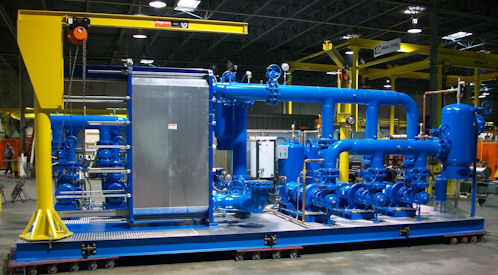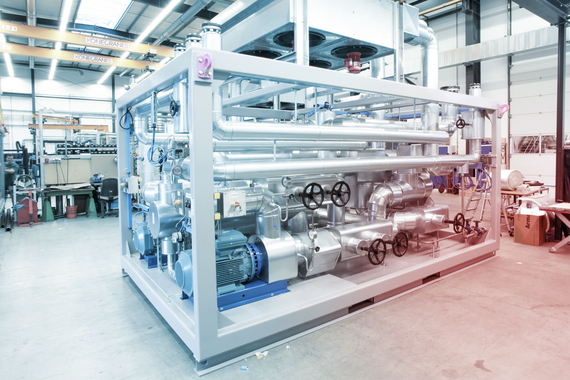Advancements in Heat Transfer Solutions: What You Need to Know for Optimal Efficiency
Developments in Heat transfer systems are transforming efficiency throughout various industries. Advanced products like graphene and nanofluids guarantee considerable enhancements in thermal conductivity. The assimilation of IoT and machine understanding provides chances for real-time tracking and improved power efficiency. Nevertheless, the landscape of thermal monitoring is rapidly progressing (DVS Heat Transfer Systems). Recognizing these advancements is crucial for attaining perfect system performance and sustainability in the future. What particular improvements are forming this transformation?
Emerging Products for Enhanced Heat Transfer

Advanced Heat Exchanger Styles
While conventional Heat exchangers have actually offered their purpose in different applications, progressed designs are now emerging to satisfy the boosting demands for performance and performance. These innovative designs, such as plate, shell-and-tube, and finned-tube Heat exchangers, integrate improved surface and improved flow patterns to raise thermal transfer rates. Furthermore, portable layouts permit minimized room demands without jeopardizing efficiency. Advanced materials, such as compounds and corrosion-resistant alloys, furthermore enhance durability and efficiency under extreme problems. Simulation technologies and computational fluid characteristics are significantly used to fine-tune these layouts, ensuring peak Heat transfer characteristics. As markets seek to minimize energy consumption and make the most of output, the fostering of innovative Heat exchanger layouts is pivotal in achieving these purposes.
The Role of Nanotechnology in Heat Transfer
Nanotechnology plays a necessary function in boosting thermal conductivity within Heat transfer systems. By manipulating materials at the nanoscale, researchers have accomplished considerable enhancements in power effectiveness. These innovations not just optimize performance but additionally contribute to even more lasting energy options.
Improved Thermal Conductivity
Significant developments in thermal conductivity have emerged via the application of nanotechnology, changing Heat transfer systems throughout various markets. By including nanoparticles into Heat transfer fluids and products, researchers have actually accomplished amazing increases in thermal conductivity. These nanoparticles, such as carbon nanotubes, graphene, and steel oxides, improve the Heat transfer residential or commercial properties due to their high area and unique thermal characteristics. The resulting composites show enhanced efficiency in applications ranging from electronic devices cooling down systems to renewable resource innovations. Additionally, the ability to tailor the dimension, form, and make-up of nanoparticles enables for enhanced thermal monitoring remedies. Consequently, nanotechnology continues to play a critical duty in the development of much more efficient and efficient Heat transfer systems, leading the method for improved commercial applications.
Power Effectiveness Improvements

Integration of IoT in Heat Transfer Solutions
The assimilation of IoT in Heat transfer systems introduces the application of smart sensing units that improve operational performance. These sensors allow real-time information surveillance, enabling immediate changes and optimizations. This technological advancement has the potential to significantly improve performance and power management in Heat transfer applications.
Smart Sensors Application
As Heat transfer systems progress, the integration of smart sensing units through the Net of Things (IoT) has emerged as a transformative strategy. These sensors enable real-time tracking of temperature, circulation, and stress rates, improving system performance and integrity. By collecting and sending data, they promote positive upkeep, reducing the danger of system failures. In addition, smart sensing units add to power cost savings by refining functional parameters based on environmental conditions. Their ability to examine anomalies and fads enables for informed decision-making, making sure peak efficiency of Heat transfer systems. As markets increasingly embrace this technology, the implementation of wise sensing units stands to transform just how Heat transfer systems are managed, leading the way for better sustainability and improved efficiency results.
Real-Time Data Monitoring
How can real-time data keeping track of improve the effectiveness of Heat transfer systems? By integrating Net of Things (IoT) modern technology, Heat transfer systems can leverage continual information collection from smart sensors. This real-time tracking enables prompt evaluation of stress, circulation, and temperature level prices, making it possible for operators to identify ineffectiveness quickly. Adjustments can be made to enhance efficiency, decrease energy consumption, and prolong devices life-span. Furthermore, predictive maintenance can be implemented, lessening unforeseen downtime and pricey repair work. The capability to envision efficiency metrics via control panels boosts decision-making, cultivating a positive method to system monitoring. Inevitably, real-time data monitoring not only improves functional effectiveness but likewise contributes to sustainability goals within commercial processes.
Energy Efficiency and Sustainability Trends
Energy performance and sustainability fads are improving the landscape of Heat transfer systems, driving technology and compliance across numerous markets. Organizations are increasingly focusing on energy-efficient layouts to decrease functional expenses and decrease environmental effects. The assimilation of sustainable power sources is ending up being extra widespread, making it possible for Heat transfer systems to operate sustainably while satisfying regulatory requirements. In addition, improvements in materials and technologies advertise reduced power usage and boost general performance. Lifecycle assessments are additionally gaining grip, allowing firms to evaluate the environmental effect of Heat transfer systems from manufacturing to disposal. This focus on sustainability not only supports corporate duty but likewise settings companies competitively in a market where consumers progressively favor green remedies. Energy effectiveness and sustainability stay important considerations for future developments in Heat transfer innovation.
Advancements in Thermal Administration Solutions
While the need for effective Heat transfer remains to climb, developments in thermal management remedies are emerging to address both performance and sustainability difficulties. Advanced products, such as stage change materials and nanofluids, are being established to improve Heat transfer effectiveness - DVS Heat Transfer Systems. These materials boost thermal conductivity and enable far better temperature law in different applications. In addition, technologies like active thermal control systems are getting traction, enabling real-time adjustments to take care of Heat circulation successfully. These systems add to energy cost savings and decrease the ecological effect of thermal processes. The assimilation of IoT in thermal administration facilitates surveillance and anticipating maintenance, making certain enhanced efficiency and long life of Heat transfer systems. Overall, informative post these innovations stand for substantial strides towards even more sustainable thermal management techniques
Future Instructions in Heat Transfer Technology
Arising developments in thermal monitoring services signify a promising future for Heat transfer technology. Scientists are significantly concentrating on establishing materials with premium thermal conductivity and boosted power efficiency. Advancements such as nanofluids, which website here contain put on hold nanoparticles, supply substantial improvements in Heat transfer efficiency. Additionally, the integration of smart materials that adjust to varying temperature conditions is getting traction, enabling even more receptive and effective systems. The increase of additive production techniques is additionally enabling the design of intricate Heat exchanger geometries that maximize liquid circulation. Moreover, the implementation of artificial intelligence formulas is expected to transform the optimization of Heat transfer systems, assisting in anticipating maintenance and efficiency improvement. Collectively, these advancements are poised to change the landscape of Heat transfer modern technologies in numerous sectors.

Regularly Asked Questions

How Do I Select the Right Heat Transfer System for My Application?
Choosing the ideal Heat transfer system involves examining application needs, including temperature varieties, liquid buildings, and effectiveness needs. Assessing system types, maintenance considerations, and cost-effectiveness likewise plays a necessary function in making an educated decision.
What Are the Upkeep Requirements for Advanced Heat Exchangers?
Maintenance requirements for innovative Heat exchangers commonly include routine examinations, monitoring for leaks, cleansing of surface areas, and ensuring suitable flow prices. Abiding by maker standards guarantees reliable procedure and extends the equipment's life expectancy.
Just How Do Ecological Factors Influence Heat Transfer Effectiveness?
Ecological elements considerably influence Heat transfer efficiency. Variants in air flow, moisture, and temperature impact thermal conductivity and convective Heat transfer, eventually affecting system efficiency and requiring consideration during the design and operation of Heat transfer systems.
What Safety Criteria Apply to Heat Transfer Equipments?
Safety standards for Heat transfer systems usually include standards from organizations such as ASME and ASTM. DVS Heat Transfer Systems. These requirements address products, style, and functional methods to assure dependability, performance, and security versus hazards in various applications
How Can I Fix Usual Heat Transfer System Issues?
Fixing common Heat transfer system issues includes inspecting for leaks, making sure correct fluid circulation, examining insulation integrity, and verifying temperature differentials. Identifying these variables can aid maintain system efficiency and prevent further complications.
Nanotechnology plays a necessary function in enhancing thermal conductivity within Heat transfer systems. Significant advancements in thermal conductivity have arised via the application of nanotechnology, reinventing Heat transfer systems DVS Heat Transfer Systems across various sectors. Developments in thermal conductivity with nanotechnology have actually led the method for remarkable enhancements in energy performance within Heat transfer systems. Power performance and sustainability fads are improving the landscape of Heat transfer systems, driving innovation and compliance across numerous sectors. The combination of IoT in thermal monitoring assists in tracking and anticipating upkeep, guaranteeing maximized efficiency and long life of Heat transfer systems.